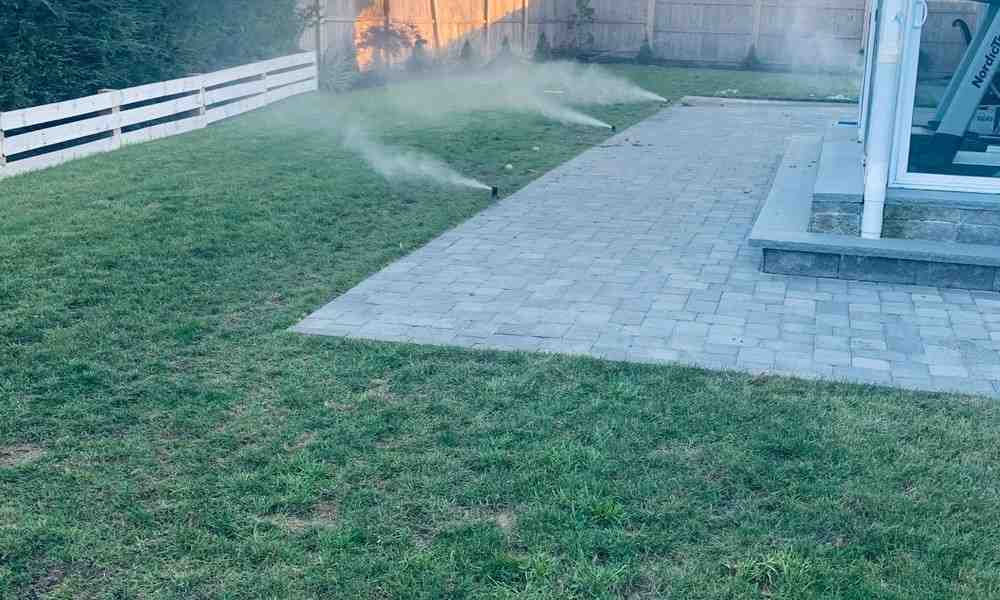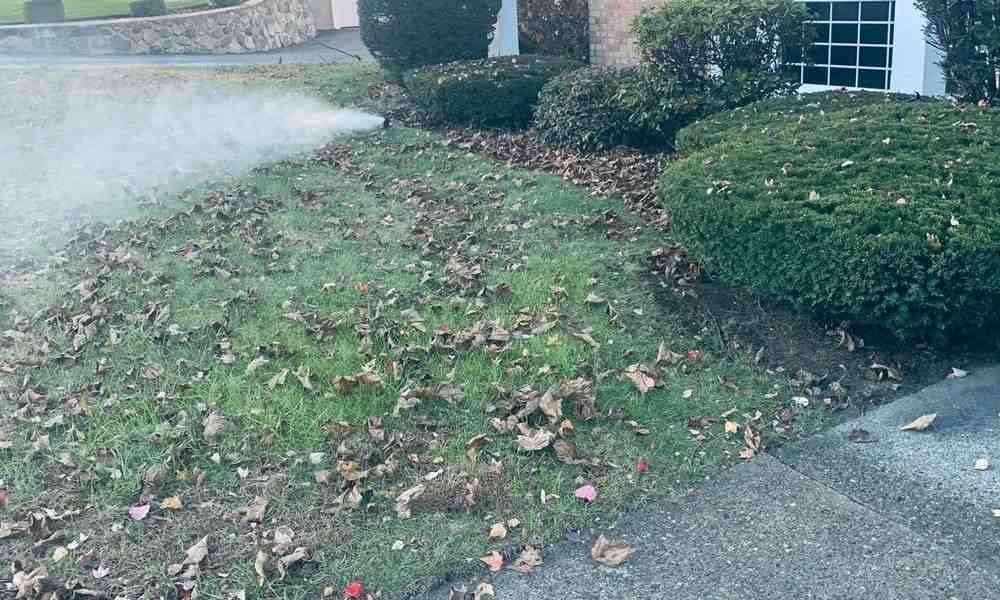Protecting Your Irrigation System This Winter
Irrigation system winterization is crucial for homeowners in cold climates. It prevents costly damage and ensures your system is ready for spring.
Here are the key steps:
- Shut off the water supply and insulate pipes.
- Turn off the timer on automatic systems.
- Drain the water using manual, automatic, or blow-out methods.
- Insulate above-ground components like valves and backflow preventers.
Winterizing your irrigation system protects it from freezing temperatures, which can cause pipes to crack and valves to break. This simple maintenance can save you from expensive repairs and keep your system running efficiently for years. Whether you do it yourself or hire a professional, taking these steps now will help your landscape thrive when the warm weather returns.
Why Winterize Your Irrigation System?
Winterizing your irrigation system is essential for several reasons. It helps prevent freezing, avoid costly repairs, and maintain system longevity. Let’s explore these benefits.
Prevent Freezing
When temperatures drop, any water left in your irrigation system can freeze. Water expands when it freezes, which can cause pipes to crack and sprinkler heads to break. By winterizing your system, you remove this water, reducing the risk of damage.
Avoid Costly Repairs
Repairing a damaged irrigation system can be expensive. Cracked pipes and broken valves often require professional repair services. By taking the time to winterize, you can save money by avoiding these costly repairs.
“Your goal isn’t water removal, it’s room for water expansion when it freezes.” – Reddit
Maintain System Longevity
Regular maintenance, including winterization, extends the lifespan of your irrigation system. A well-maintained system operates more efficiently and lasts longer, providing consistent water to your plants year after year.

Winterizing your irrigation system is a small investment of time and money that pays off in the long run. It’s a crucial step to ensure your system remains in top shape, ready to keep your landscape beautiful when spring arrives.
Next, we will explore the steps to winterize your irrigation system effectively.
Steps to Winterize Your Irrigation System
Step 1: Shut Off the Water Supply
First, shut off the water supply to your irrigation system. Locate the main shut-off valve, usually found near the water meter or the backflow prevention device.
To protect the valve from freezing, wrap it with foam insulation tape and cover it with a plastic bag. This helps to keep the cold air out and prevents any potential damage from freezing temperatures. If you don’t have a main shut-off valve, consider installing one as a preventative measure.
Step 2: Turn Off the Timer
If you have an automatic irrigation system, you’ll need to turn off the timer or controller. Most controllers have a “rain-mode” setting that stops the valves from activating but keeps your programming intact. This means your start times, valve run times, and other settings will remain saved.
For added precaution, if your controller activates a pump, disconnect the wires connected to the Master Valve (MV) and common terminals. This prevents accidental activation, which could cause overheating.
Step 3: Drain the Water
Next, you need to drain the water from the pipes and sprinklers to prevent freezing and expansion, which can damage your system. There are three common methods to do this:
Manual Drain Method:
- Shut off the water supply.
- Open the manual drain valves to let the water flow out.
- Drain the backflow device by opening its valves.
Automatic Drain Method:
- Activate the system to relieve pressure.
- The automatic drain valves will open and release the water.
Blow-Out Method:
- Connect an air compressor to the irrigation system using a coupler.
- Gradually increase the air pressure (do not exceed 80 PSI for PVC pipes or 50 PSI for polyethylene pipes).
- Open each zone one at a time, starting with the farthest from the compressor, until all water is expelled.

Safety Tip: Avoid standing near active sprinkler heads during the blow-out process.
Step 4: Insulate Above-Ground Components
Lastly, insulate any above-ground components such as backflow preventers and valves. Use foam covers or insulation tape to wrap these parts, ensuring they are protected from harsh winter conditions.
Be careful not to block air vents and drain outlets on backflow preventers. Proper insulation helps prevent freezing and extends the life of your irrigation system.
By following these steps, you can effectively winterize your irrigation system and protect it from winter damage.
Next, we will discuss the various methods for draining your irrigation system in more detail.
Methods for Draining Your Irrigation System
When it comes to irrigation system winterization, draining the water from your system is crucial. There are three main methods: manual drain, automatic drain, and the blow-out method. Each method has its own steps and considerations.
Manual Drain Method
The manual drain method is straightforward and involves a few simple steps:
- Shut off the water supply to the irrigation system.
- Locate the manual drain valves at the ends and low points of the piping.
- Open all the valves to let the water flow out.
- Drain the backflow device by opening its valves.
If your sprinklers have check valves, raise the sprinkler heads to allow water to drain out. Once the system is fully drained, close all the valves.
Automatic Drain Method
For systems equipped with automatic drain valves, the process is even easier:
- Turn off the water supply to the system.
- Briefly run one of the sprinkler heads to relieve the water pressure in the system.
- The automatic drain valves will open and release the remaining water.
You may still need to drain the water between the shut-off valve and the backflow device manually. If your sprinkler heads have check valves, empty them separately.
Blow-Out Method
The blow-out method uses compressed air to force water out of the irrigation system. This method is effective but requires caution:
- Shut down the water supply and connect an air compressor to the irrigation system using a coupler.
- Find the sprinkler station farthest from the compressor and turn it on.
- Close the backflow valves.
- Slowly open the valve on the compressor to gradually add air pressure. Do not exceed 80 PSI for PVC pipes or 50 PSI for polyethylene pipes.
- Once you see water coming through, activate each zone one at a time, starting with the farthest from the compressor.
- Shut off each zone when the spray of water ends.
- When all zones are clear, disconnect the compressor and release any remaining air pressure from the system.
- Finally, open and close the valves on the backflow device and manual drain valves to release any pent-up air pressure.
Safety Tip: Always wear safety glasses and avoid standing near active sprinkler heads during the blow-out process to prevent injury.
By understanding and using these methods, you can effectively drain your irrigation system and protect it from winter damage. Next, we’ll explore the benefits of hiring professional winterization services and how to find the right provider.
Hiring Professional Winterization Services
What to Look for in a Service Provider
Hiring a professional for your irrigation system winterization can save you time and prevent costly mistakes. Here’s what to look for:
Experience: Choose a provider with a proven track record. Experienced professionals know how to handle different systems and can spot potential issues before they become major problems.
Equipment: Ensure the provider uses the right equipment. For example, a high-quality air compressor is crucial for the blow-out method. Proper tools make the process safer and more effective.
Customer Reviews: Check online reviews to see what other customers say. Look for consistent feedback about punctuality, quality of work, and customer service. Websites like Yelp and Google Reviews are great places to start.
Service Guarantees: A good provider will stand by their work. Look for companies that offer guarantees or warranties on their services. This shows they are confident in their work and willing to fix any issues that arise.
Cost of Professional Winterization
Average Costs: The cost of professional winterization services typically ranges from $75 to $150. This price can vary based on the size of your system and your location.
Factors Affecting Price:
- System Size: Larger systems with more zones will cost more to winterize.
- Complexity: Systems with advanced features like smart controllers or multiple water sources may require more time and expertise.
- Location: Prices can vary by region. Urban areas may have higher labor costs than rural areas.
- Service Inclusions: Some providers offer additional services like system inspections or minor repairs as part of their winterization package.
Cost vs. DIY: While DIY winterization can save money, it’s labor-intensive and risky. Mistakes can lead to costly repairs. Professional services ensure your system is properly winterized, giving you peace of mind and potentially saving money in the long run.
By hiring a professional, you can ensure your irrigation system is ready for winter, preventing damage and extending its lifespan. Next, we’ll answer some frequently asked questions about irrigation system winterization.
Frequently Asked Questions about Irrigation System Winterization
Can I Winterize My Own Sprinkler System?
Yes, you can winterize your own sprinkler system, but it requires careful steps and the right tools.
- Shut Off the Water Supply: Locate the main shut-off valve, usually near your water meter, and turn it off.
- Turn Off the Timer: Switch your system to “rain mode” if available. This keeps your settings intact without running the system.
- Drain the Water: Use one of the methods below to clear out any remaining water.
- Insulate Above-Ground Components: Apply foam covers to backflow preventers and valves to protect them from freezing.
Safety Tips:
- Wear Protective Gear: When using an air compressor, wear safety glasses and gloves.
- Check Electrical Components: Ensure all electrical components are turned off to avoid any accidents.
- Follow Manufacturer Instructions: Always refer to your system’s manual for specific instructions.
When to Hire a Professional:
- Lack of Equipment: If you don’t have access to an air compressor or other necessary tools.
- Complex Systems: If your system has multiple zones or advanced features.
- Peace of Mind: To avoid the risk of costly mistakes, especially if you’re not confident in your DIY skills.
What Happens if You Don’t Winterize Your Sprinkler System?
Failing to winterize your irrigation system can lead to serious problems:
Potential Damage:
- Frozen Pipes: Water left in the pipes can freeze, causing them to burst.
- Cracked Fittings: Expanding ice can crack fittings and valves, leading to leaks.
Repair Costs:
- Pipe Replacement: Fixing burst pipes can cost hundreds of dollars.
- System Overhaul: Severe damage might require a complete system overhaul, costing even more.
System Longevity:
- Reduced Lifespan: Regular winterization extends the life of your system by preventing damage.
- Consistent Performance: Proper maintenance ensures your system works efficiently year after year.
How Do I Winterize My Sprinklers Without a Pump?
If you don’t have a pump, you can still winterize your system using manual draining or automatic draining methods.
Manual Draining:
- Shut Off Water: Turn off the main water supply to your sprinkler system.
- Open Valves: Open all manual drain valves, usually located at the ends or low points of your system.
- Drain Backflow Device: Open the drain valve on your backflow preventer to release any trapped water.
Automatic Draining:
- Activate System: Turn on your system briefly to relieve pressure.
- Relieve Pressure: Open the automatic drain valves. These valves will automatically open when the system pressure drops below a certain level.
- Check for Complete Drainage: Ensure all water has been drained from the pipes and components.
Alternative Methods:
- Gravity Drainage: In some systems, simply opening the valves and letting gravity do the work can be effective.
- Professional Help: If these methods seem daunting, hiring a professional is always a safe bet.
By following these steps, you can protect your irrigation system from winter damage, even without specialized equipment. Proper winterization ensures your system is ready to go in the spring, avoiding costly repairs and extending its lifespan.
Next, we’ll dig into the importance of regular maintenance to keep your irrigation system running smoothly year-round.
Conclusion
Winterizing your irrigation system is crucial to prevent damage, avoid costly repairs, and ensure your system’s longevity.
Let’s recap the essential steps:
- Shut Off the Water Supply: Turn off the main shut-off valve and insulate it to protect it from freezing.
- Turn Off the Timer: Switch your system to “rain mode” or shut off the power to the controller.
- Drain the Water: Use manual, automatic, or blow-out methods to remove water from the pipes.
- Insulate Above-Ground Components: Wrap backflow preventers and valves with foam covers.
By following these steps, you protect your irrigation system from winter’s harsh conditions. This proactive approach can save you from expensive repairs and ensure your system is ready for spring.
At Best In Irrigation, LLC, we specialize in providing custom irrigation solutions for residential and commercial landscapes in Massachusetts. With our focus on water conservation and cutting-edge technology, we bring 9 years of trusted expertise to the New England region.
Ready to protect your irrigation system? Contact Best In Irrigation for professional winterization services and enjoy peace of mind knowing your system is in expert hands.
Winterizing your irrigation system is a small investment in time and effort that pays off in the long run. Don’t wait until it’s too late—take action now to ensure your system’s longevity and efficiency.



